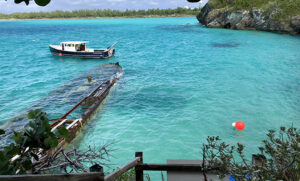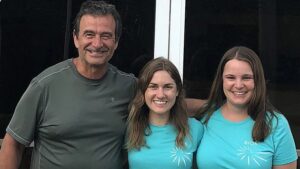An Environmental Engineering Challenge, with a Twist

A new project, funded by the National Geographic Society, is bringing a diverse group of teachers and students together to address the issue of invasive lionfish in Bermuda. Building connections between students from different cultural, geographic, and socioeconomic backgrounds is key to the National Geographic Society concept of “geo-inquiry,” which encourages students to use their unique perspectives to analyze connections and solve real-world problems.
How could a group of 15 students from diverse cultural and socioeconomic backgrounds—and separated by hundreds of miles— work together to address a real-world ecological issue? That’s what a team of educators is set to find out with new funding from the National Geographic Society.
Their project, entitled “International Geo-Inquiry for the United Nations Sustainable Development Goals,” was funded by one of National Geographic Society’s Early Career Grants, which are designed to offer less experienced scientists and educators the opportunity to lead a project.
Last June, Kate Craven, the grant’s principal investigator and a writing, technology, and media teacher at Ashford School in rural Connecticut, and her colleague Carly Imhoff, were inspired to apply for the grant after attending the BIOS Educator Workshop. During the workshop, BIOS scientists and educators introduced participants to the issue of invasive lionfish, and how they are threatening Bermuda’s natural marine biodiversity with their voracious appetites and high reproductive capacities.
This got Craven thinking.
“Engineering challenges, like building popsicle bridges and robots that paint, are fun and engaging but they don’t solve pressing sustainable development issues such as halting the loss of biodiversity and restoring marine ecosystems,” she said.

Kate Craven (center), the project’s principal investigator and a writing, technology, and media teacher at Ashford School in Connecticut, and her colleague Carly Inhoff (right), were inspired to apply for the grant after attending the BIOS Educator Workshop last summer. Mark Supal (left), a science teacher at the Macomb Mathematics Science Technology Center, was another workshop attendee and is collaborating on the grant with students from his school, which is located in urban Detroit, Michigan.
Making Geography Relevant
Her answer was to create a replicable program that promotes collaboration between students worldwide by developing solutions that improve global sustainability. Specifically, the project will rely on a National Geographic Society concept called “geo-inquiry,” which encourages students to use their unique geographic perspectives to analyze connections between humans and nature.
“I teach in a diverse community, and I see how geography influences student perspective and understanding of the world in powerful ways,” Craven said. “I also understand the importance of providing students with diverse perspectives, both to help them understand the interconnectedness of the larger world and to give them additional perspective and solutions for their own local community.”
The most meaningful way for students to develop this perspective, she said, is by building connections with others in a variety of locations.
Craven visualized a project that would engage students from different cultural, geographic, and socioeconomic backgrounds in an engineering task that ultimately benefits the environment. To achieve this diversity, she reached out to Mark Supal, a fellow workshop attendee and science teacher at the Macomb Mathematics Science Technology Center in urban Detroit, Michigan, as well as Kaitlin Noyes, director of BIOS’s Ocean Academy. Both were interested in her proposal.
Investigating an Invasive Species
Beginning this April, 15 students from Bermuda, Michigan, and Connecticut will spend six months using the geo-inquiry process to engineer solutions to preserve Bermuda’s marine biodiversity. Their primary task is to design and build underwater robots to collect data about lionfish, such as geographic location, behavior, or water samples to look for environmental DNA, also known as eDNA.
Fish continually release eDNA into the surrounding environment through waste material, old scales, mucous, and reproductive cells. Rather than sampling directly from fish, scientists can use eDNA to identify which species are present in the area at the time of the sample.
Using shared video communication programs, students will collaboratively design their underwater robots, equipping them with video cameras, water sampling tools, and other data collection mechanisms. After completing the design process, they will have the opportunity to participate in an engineering design contest to test their robots’ abilities to seek out and identify as many lionfish as possible within a given time period.
Throughout the investigation, the students will also develop Story Maps, a type of graphic organizer that combines GIS data, text, and multimedia content to help develop a framework for ideas and information. These Story Maps can then be shared with students and teachers around the world, allowing them insight into the design and testing process, as well as how geo-inquiry forms the foundation for addressing real-world challenges.
Connecting the Pieces in Bermuda
From May 29 through June 1, the teams from Connecticut and Michigan will travel to Bermuda to meet their Bermudian counterparts and spend four days at BIOS. During the first two days, students will learn about the invasive lionfish problem in Bermuda and explore case studies highlighting the importance of protecting endemic species. The remainder of the time at BIOS will be spent testing their underwater robots in Bermuda’s waters, with the outcomes being used to modify their designs after returning home.
As a crucial component of the geo-inquiry process, students will also have the opportunity to connect with the local environment by visiting Nonsuch Island and planting native tree species on Cooper’s Island, as well as snorkeling and observing native fish. These experiences will be added into their case studies and Story Maps, allowing the students to draw upon real, personal stories, in addition to data points collected by their robots.
“BIOS is the perfect place to bring schools together to learn hands-on methods for solving 21st century problems with new technologies,” Noyes said. Supal added that students will also gain first-hand exposure to the challenges of sustainability while also having access to expert scientists, graduate students, and scientific resources.
To make the project globally relevant and applicable to other diverse populations, Craven and her colleagues designed the project to address United Nations Sustainable Development Goals (SDGs), a blueprint for addressing global issues related to climate, environmental degradation, poverty, inequality, and prosperity. Specifically, this project addresses Goal 14: Life Under Water, which aims to sustainably manage and protect marine and coastal ecosystems. Throughout the project, students will be assessed to learn how they are using the geo-inquiry process as a means of improving life under water and achieving a sustainable balance between people and the sea.
The educators involved with the project will be developing a suite of specific lesson plans that can be used by other schools, and creating both a website and a blog to demonstrate how the geo-inquiry process can be used to meet the United Nations SDGs. This latter aspect is particularly important for educators in developing countries, as there are funding opportunities specific to projects that address SDGs. The team is also planning on writing a complementary e-book that details a framework for international geo-inquiry projects for use by schools around the world.
